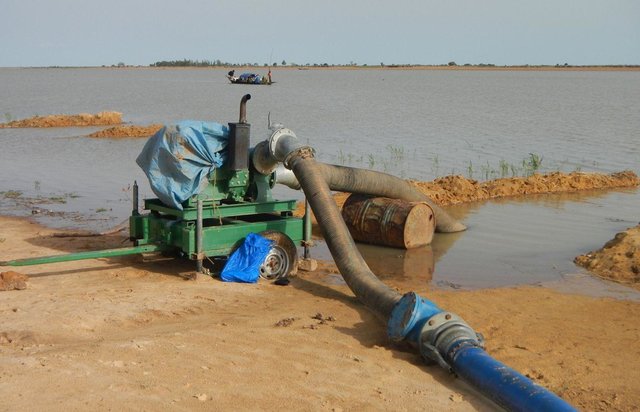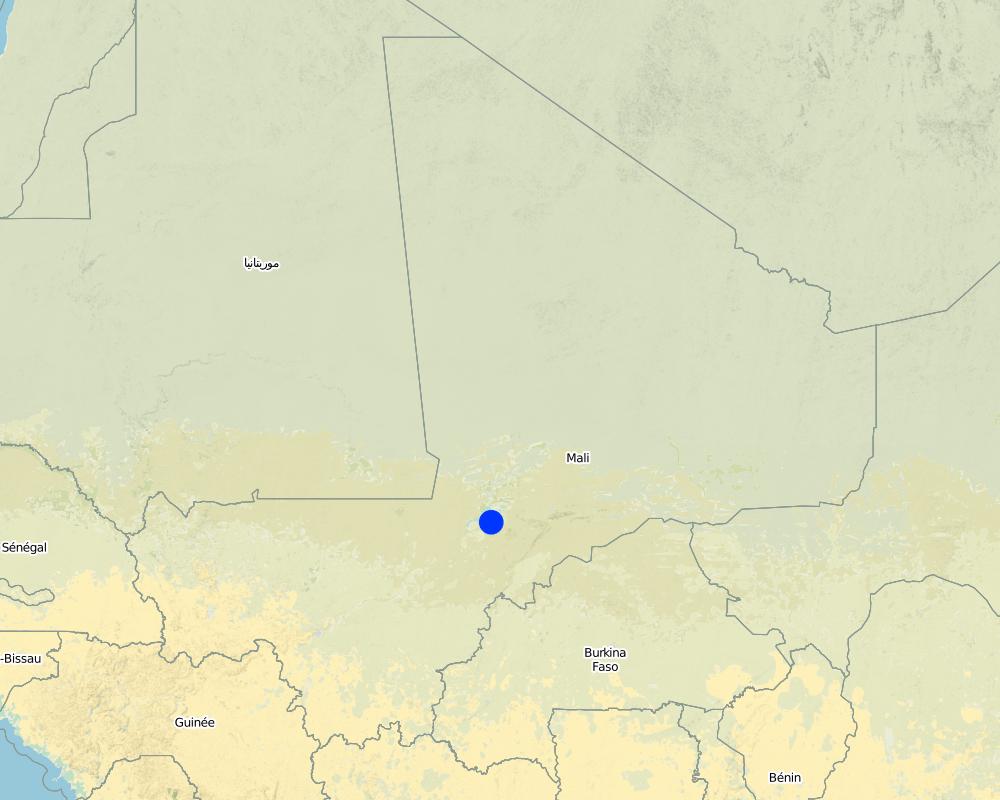Participatory approach to small-scale irrigation [Mali]
- Criação:
- Atualização:
- Compilador/a: Dieter Nill
- Editor: –
- Revisor: Laura Ebneter
Approche participative dans l’irrigation de proximité
approaches_2513 - Mali
Veja as seções
Expandir tudo Recolher tudo1. Informação geral
1.2 Detalhes do contato das pessoas capacitadas e instituições envolvidas na avaliação e documentação da abordagem
Especialista em GST:
Kone Mamadou Gallo
gallokone@yahoo.fr
IPRO-DB Bélédougou
Mali
Especialista em GST:
Schneider Ralf
ralf_schneider5@hotmail.com
IPRO-DB Bélédougou
Mali
Especialista em GST:
Ouologuem Abass
ouologuemabass@yahoo.fr
IPRO-DB Bélédougou
Mali
Nome do projeto que facilitou a documentação/avaliação da Abordagem (se relevante)
Le Projet Irrigation de Proximité au Pays Dogon et dans le Bélédougou, Mali (IPRO-DB)Nome da(s) instituição(ões) que facilitou(ram) a documentação/avaliação da Abordagem (se relevante)
Deutsche Gesellschaft für Internationale Zusammenarbeit (GIZ) GmbH (GIZ) - Alemanha1.3 Condições em relação ao uso da informação documentada através de WOCAT
Quando os dados foram compilados (no campo)?
01/07/2012
O/a compilador/a e a(s) pessoa(s) capacitada(s) aceitam as condições relativas ao uso de dados documentados através da WOCAT:
Sim
1.4 Referência ao(s) questionário(s) sobre tecnologias da GST

Irrigation using a Californian network [Mali]
A micro-irrigation system to use water more efficiently and increase yields
- Compilador/a: Dieter Nill

Village irrigation schemes developed using the PMN/IPRODI approach [Mali]
Village irrigation schemes (VISs) help to control the water supply and significantly increase yields.
- Compilador/a: Dieter Nill
2. Descrição da abordagem de GST
2.1 Descrição curta da abordagem
The participatory approach to small-scale irrigation ensures skills and expertise are transferred to scheme beneficiaries and other stakeholders.
2.2 Descrição detalhada da abordagem
Descrição detalhada da abordagem:
The participatory approach to small-scale irrigation (SI) ensures skills and expertise are transferred to scheme beneficiaries and other stakeholders. This enhances the value of investments and the sustainability of installations.
Direct beneficiaries (villagers) and indirect beneficiaries (technical services, communes) are involved before, during and after the installation of irrigation systems in order to ensure the sustainability of the schemes and a long-term return on investment.
Firstly, all the actors involved in the schemes are identified. Beneficiaries’ concerns are taken into account and the participation of relevant actors is ensured throughout the process. The following factors are essential when applying this approach: 1) the commitment of beneficiaries to engage in the project approach; 2) an explicit request made by beneficiaries for the scheme in question; 3) an agreement to relay the content of meetings to all beneficiaries; 4) an awareness of potentially significant constraints such as property issues, a lack of villagers available to provide labour, and the payment of financial contributions.
The participatory approach enhances the sustainability of investments, while the cost of participation remains low. The prevention and management of conflicts, the commitment of beneficiaries to schemes and the uptake of construction and management techniques by beneficiaries are all factors that contribute to sustainability.
The support structure (IPRO-DB) offers assistance in identifying the actors to involve, organises meetings, monitors information events for villagers (known as restitution sessions) and provides financial support. The village committee participates in all meetings, keeps villages informed, acts as an intermediary between associations, support structures and the community, and organises meetings. Farmers’ associations constitute sources of information, identify needs, draw up bylaws, contribute labour and funds to activities and participate in decision-making in village councils. Technical services provide advisory support and constitute sources of information. The commune provides information, raises the awareness of the actors involved, invites beneficiaries to the exchange meetings, identifies the actors involved and approves villagers’ requests.
The approach was implemented in eight villages with a combined population of around 9,240 people. The schemes cover a total area of around 766 hectares of farmland. Duration of application: Since 2005.
2.5 País/região/locais onde a abordagem foi aplicada
País:
Mali
Região/Estado/Província:
Mali
Especificação adicional de localização:
Kambila, Nonkon, Nossombougou, N’Tjiba, Kolokani, Tioribougou
Map
×2.6 Datas de início e término da abordagem
Indique o ano de início:
2005
2.7 Tipo de abordagem
- Baseado em projeto/programa
2.8 Principais metas/objetivos da abordagem
The participatory approach to small-scale irrigation (SI) ensures skills and expertise are transferred to scheme beneficiaries and other stakeholders. This enhances the value of investments and the sustainability of installations. Direct beneficiaries (villagers) and indirect beneficiaries (technical services, communes) are involved before, during and after the installation of irrigation systems in order to ensure the sustainability of the schemes and a long-term return on investment.
The SLM Approach addressed the following problems: lack of skills and expertise, lack of involvement of beneficiaries before, during and after the installation of irrigation systems
2.9 Condição que propiciam ou inibem a implementação de tecnologia/tecnologias aplicada(s) segundo a abordagem
Quadro institucional
- Inibitivo
lack of involvement of beneficiaries
Treatment through the SLM Approach: Direct beneficiaries (villagers) and indirect beneficiaries (technical services, communes) are involved before, during and after the installation of irrigation systems in order to ensure the sustainability of the schemes and a long-term return on investment.
Conhecimento sobre GST, acesso a suporte técnico
- Inibitivo
lack of skills and expertise,
Treatment through the SLM Approach: participatory approach to small-scale irrigation (SI) ensures skills and expertise are transferred to scheme beneficiaries and other stakeholders
3. Participação e papel das partes interessadas envolvidas
3.1 Partes interessadas envolvidas na abordagem e seus papéis
- Usuários de terra/comunidades locais
- Especialistas em GST/ consultor agrícola
- Organização não governamental
- Governo local
- Governo nacional (planejadores, responsáveis pelas decisões)
3.2 Envolvimento do usuários de terra/comunidades locais nas diferentes fases da abordagem
| Envolvimento do usuários de terra/comunidades locais | Especifique quem estava envolvido e descreva as atividades | |
|---|---|---|
| Iniciação/motivação | Passivo | |
| Planejamento | Participativo | |
| Implementação | Participativo | |
| Monitoramento/avaliação | Participativo | |
| Research | Passivo |
3.4 Decisão sobre a seleção de tecnologia/tecnologias de GST
Especifique quem decidiu sobre a seleção de tecnologia/tecnologias a serem implementadas:
- Principalmente especialistas em GST, após consulta com usuários da terra
Explique:
Decisions on the method of implementing the SLM Technology were made by mainly by SLM specialists with consultation of land users
4. Suporte técnico, reforço das capacidades e gestão do conhecimento
4.1 Reforço das capacidades/ formação
Foi oferecida formação aos usuários da terra/outras partes interessadas?
Sim
Especifique quem foi capacitado:
- Usuários de terra
Tipo de formação:
- Em exercício
- Reuniões públicas
- Cursos
4.2 Serviço de consultoria
Os usuários de terra têm acesso a um serviço de consultoria?
Sim
Especifique se foi oferecido serviço de consultoria:
- nas áreas dos usuários da terra
Descreva/comentários:
Advisory service is quite adequate to ensure the continuation of land conservation activities
4.3 Fortalecimento da instituição (desenvolvimento organizacional)
As instituições foram fortalecidas ou estabelecidas através da abordagem?
- Sim, moderadamente
Especifique a que nível (níveis) as instituições foram fortalecidas ou estabelecidas:
- Local
Especifique o tipo de apoio:
- Financeiro
- Reforço das capacidades/ formação
- Equipamento
4.4 Monitoramento e avaliação
Monitoramento e avaliação são partes da abordagem?
Sim
Comentários:
technical aspects were ad hoc monitored by project staff through observations
socio-cultural aspects were ad hoc monitored by project staff through observations
no. of land users involved aspects were ad hoc monitored by project staff through observations
management of Approach aspects were ad hoc monitored by project staff, land users through observations
There were no changes in the Approach as a result of monitoring and evaluation
There were no changes in the Technology as a result of monitoring and evaluation
4.5 Pesquisa
A pesquisa foi parte da abordagem?
Sim
Especifique os tópicos:
- Sociologia
- Tecnologia
Dê mais detalhes e indique quem realizou a pesquisa:
Research was carried out on station
5. Financiamento e apoio material externo
5.1 Orçamento anual para o componente de GST da abordagem
Comentários (p. ex. principais fontes de recursos/principais doadores):
Approach costs were met by the following donors: international (IPRO-DB): 100.0%
5.2 Apoio financeiro/material concedido aos usuários da terra
Os usuários da terra receberam apoio financeiro/material para a implementação de tecnologia/tecnologias?
Sim
5.3 Subsídios para entradas específicas (incluindo mão-de-obra)
Se a mão-de-obra pelos usuários da terra foi uma entrada substancial, isso foi:
- Voluntário
5.4 Crédito
Foi concedido crédito segundo a abordagem para atividades de GST?
Não
6. Análise de impactos e declarações finais
6.1 Impactos da abordagem
A abordagem auxiliou os usuários da terra a implementar e manter as tecnologias de GST?
- Não
- Sim, pouco
- Sim, moderadamente
- Sim, significativamente
The participatory approach ensures skills and expertise are transferred to scheme beneficiaries and other stakeholders. This enhances the value of investments and the sustainability of installations.
A abordagem concedeu autonomia aos grupos social e economicamente desfavorecidos?
- Não
- Sim, pouco
- Sim, moderadamente
- Sim, significativamente
Did other land users / projects adopt the Approach?
- Não
- Sim, pouco
- Sim, moderadamente
- Sim, significativamente
The approach was implemented in eight villages with a combined population of around 9,240 people. The schemes cover a total area of around 766 hectares of farmland. Duration of application: Since 2005
Did the Approach lead to improved livelihoods / human well-being?
- Não
- Sim, pouco
- Sim, moderadamente
- Sim, significativamente
The participatory approach facilitates understanding among the communes and the quick delivery of schemes requested by the commune. The labour and financial contribution provided reduces the investment costs of schemes. The likelihood of possible conflicts is reduced.
Did the Approach help to alleviate poverty?
- Não
- Sim, pouco
- Sim, moderadamente
- Sim, significativamente
6.2 Principal motivação dos usuários da terra para implementar a GST
- Produção aumentada
- Lucro (lucrabilidade) aumentado, melhora da relação custo-benefício
- Afiliação a movimento/projeto/grupo/rede
6.3 Atividades de sustentabilidade de abordagem
Os usuários da terra podem manter o que foi implementado através da abordagem (sem apoio externo)?
- Sim
6.4 Pontos fortes/vantagens da abordagem
| Pontos fortes/vantagens/oportunidades na visão do/a compilador/a ou de outra pessoa capacitada |
|---|
| The only costs incurred relate to catering and venue charges for the training workshops and study trips. The cost of participating in study trips remains very low, except in cases where there is no local village with expertise in the subject in question. |
|
The participatory approach facilitates understanding among the communes and the quick delivery of schemes requested by the commune. |
| The labour and financial contribution provided reduces the investment costs of schemes. |
| The likelihood of possible conflicts is reduced. |
| skills and expertise are transferred to scheme beneficiaries |
| enhances the value of investments and the sustainability of installations |
| Direct beneficiaries (villagers) and indirect beneficiaries (technical services, communes) are involved before, during and after the installation of irrigation systems in order to ensure the sustainability of the schemes and a long-term return on investment |
7. Referências e links
7.1 Métodos/fontes de informação
- visitas de campo, pesquisas de campo
- entrevistas com usuários de terras
7.2 Referências às publicações disponíveis
Título, autor, ano, ISBN:
Manual of Good Practices in Small Scale Irrigation in the Sahel. Experiences from Mali. Published by GIZ in 2014.
Disponível de onde? Custos?
http://star-www.giz.de/starweb/giz/pub/servlet.starweb
Links e módulos
Expandir tudo Recolher tudoLinks

Irrigation using a Californian network [Mali]
A micro-irrigation system to use water more efficiently and increase yields
- Compilador/a: Dieter Nill

Village irrigation schemes developed using the PMN/IPRODI approach [Mali]
Village irrigation schemes (VISs) help to control the water supply and significantly increase yields.
- Compilador/a: Dieter Nill
Módulos
Não há módulos


